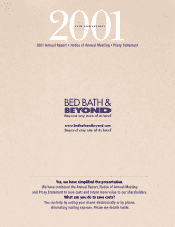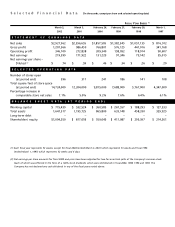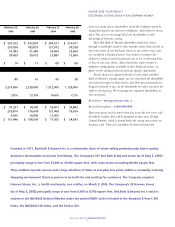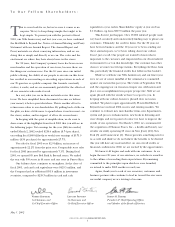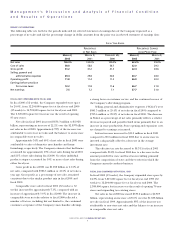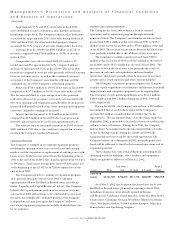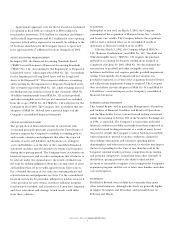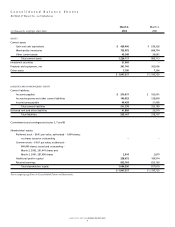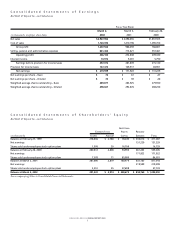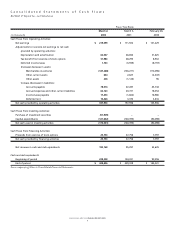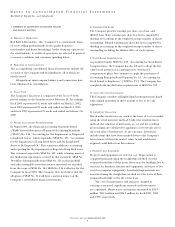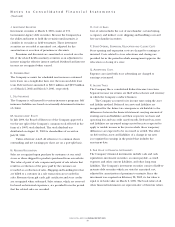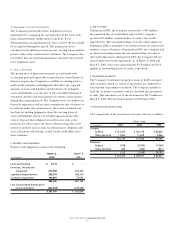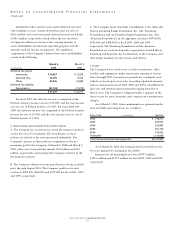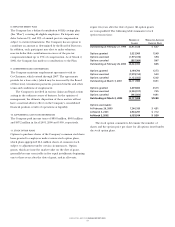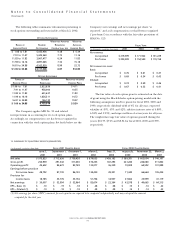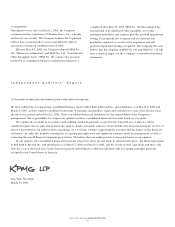Bed, Bath and Beyond 2001 Annual Report Download - page 7
Download and view the complete annual report
Please find page 7 of the 2001 Bed, Bath and Beyond annual report below. You can navigate through the pages in the report by either clicking on the pages listed below, or by using the keyword search tool below to find specific information within the annual report.
BED BATH & BEYOND ANNUAL REPORT 2001
5
Approximate aggregate costs for the 61 leased stores planned
for opening in fiscal 2002 are estimated at $88.6 million for
merchandise inventories, $54.3 million for furniture and fixtures
and leasehold improvements and $13.4 million for store opening
expenses (which will be expensed as incurred). In addition to the
61 locations already leased, the Company expects to open and
lease approximately 27 additional locations during fiscal 2002.
RECENT ACCOUNTING PRONOUNCEMENT
In August 2001, the Financial Accounting Standards Board
(“FASB”) issued Statement of Financial Accounting Standards
(“SFAS”) No. 144, “Accounting for the Impairment or Disposal of
Long-Lived Assets,” which supersedes SFAS No. 121, “Accounting
for the Impairment of Long-Lived Assets and for Long-Lived
Assets to Be Disposed Of.” This statement addresses accounting
and reporting for the impairment or disposal of long-lived assets.
The statement supersedes SFAS No. 121, while retaining many of
the fundamental provisions covered by that statement. SFAS No.
144 differs fundamentally from SFAS No. 121 in that goodwill
and other intangible assets that are not amortized are excluded
from the scope of SFAS No. 144. SFAS No. 144 is effective for the
Company in fiscal 2002. The Company does not believe that the
adoption of SFAS No. 144 will have a material impact on the
Company’s consolidated financial statements.
CRITICAL ACCOUNTING POLICIES
The preparation of financial statements in conformity with
accounting principles generally accepted in the United States of
America requires the Company to establish accounting policies
and to make estimates and judgments that affect the reported
amounts of assets and liabilities and disclosure of contingent
assets and liabilities as of the date of the consolidated financial
statements and the reported amounts of revenues and expenses
during the reporting period. The Company bases its estimates on
historical experience and on other assumptions that it believes to
be relevant under the circumstances, the results of which form
the basis for making judgments about the carrying value of assets
and liabilities that are not readily apparent from other sources.
For a detailed discussion of our critical accounting policies and
related estimates and judgments, see Note 1 to the consolidated
financial statements. In particular, judgment is used in areas such
as the provision for sales returns, inventory valuation using the
retail inventory method, and accruals for self insurance, litigation
and store relocations and closings. Actual results could differ
from these estimates.
ACQUISITION
Subsequent to year end, on March 5, 2002, the Company
consummated the acquisition of Harmon Stores, Inc., a health
and beauty care retailer. The Company believes the acquisition
will not have a material effect on its consolidated results of
operations or financial condition in fiscal 2002.
Effective March 3, 2002, the Company adopted SFAS No.
141, “Business Combinations” and SFAS No. 142, “Goodwill and
Other Intangible Assets.” SFAS No. 141 requires the purchase
method of accounting for business combinations initiated or
completed after June 30, 2001. SFAS No. 142 discontinued the
amortization of goodwill and other intangible assets with
indefinite useful lives and requires periodic goodwill impairment
testing. Consequently, the Company will not amortize any
goodwill recognized as a result of the acquisition described below
and will perform impairment testing as required. The Company
does not believe that the adoption of SFAS No. 141 and SFAS No.
142 will have a material impact on the Company’s consolidated
financial statements.
FORWARD LOOKING STATEMENTS
This Annual Report and, in particular, Management’s Discussion
and Analysis of Financial Condition and Results of Operations,
and the Shareholder Letter, contain forward looking statements
within the meaning of Section 21E of the Securities Exchange Act
of 1934, as amended. The Company’s actual results and future
financial condition may differ materially from those expressed in
any such forward looking statements as a result of many factors
that may be outside the Company’s control. Such factors include,
without limitation: general economic conditions, changes in
the retailing environment and consumer spending habits,
demographics and other macroeconomic factors that may impact
the level of spending for the types of merchandise sold by the
Company; unusual weather patterns; competition from existing
and potential competitors; competition from other channels of
distribution; pricing pressures; the ability to find suitable
locations at reasonable occupancy costs to support the Company’s
expansion program; and the cost of labor, merchandise and other
costs and expenses.
SEASONALITY
Bed Bath & Beyond stores exhibit less seasonality than many
other retail businesses, although sales levels are generally higher
in August, November and December, and generally lower in
February and March.

